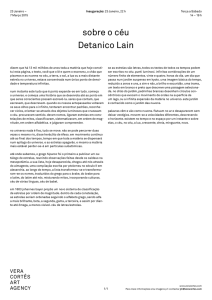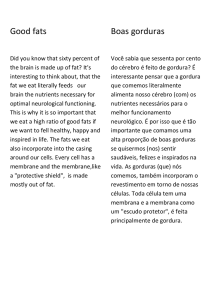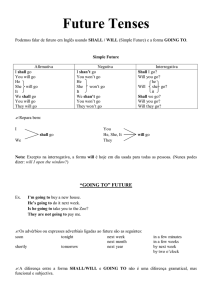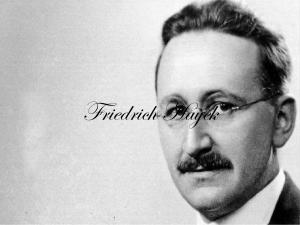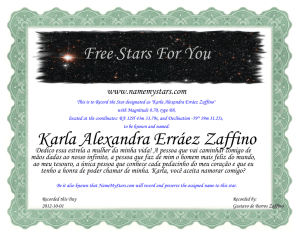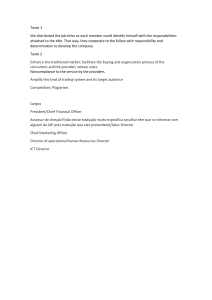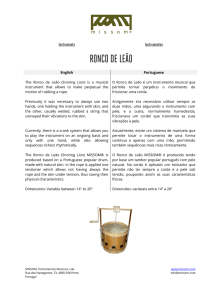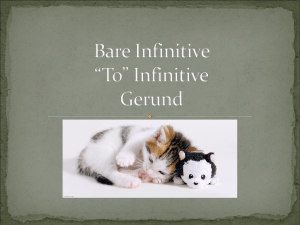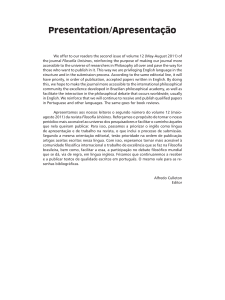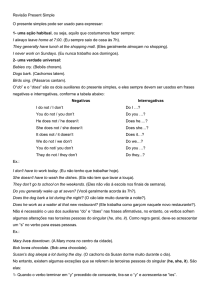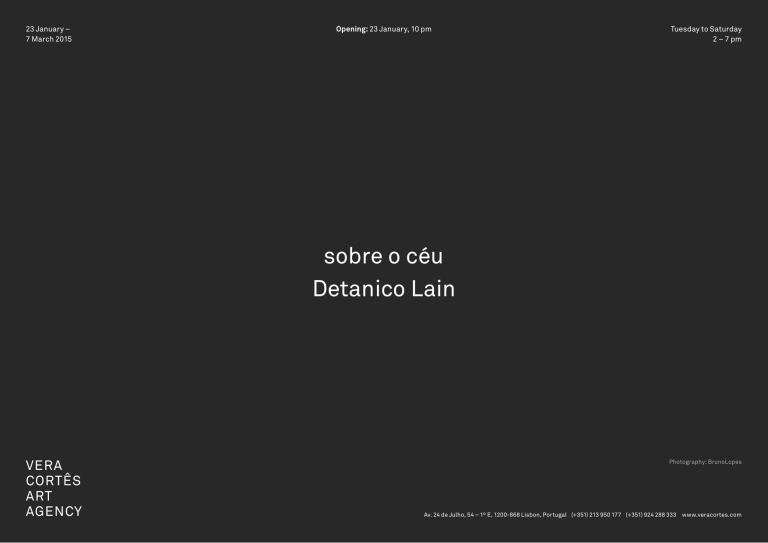
23 January –
7 March 2015
Opening: 23 January, 10 pm
Tuesday to Saturday
2 – 7 pm
sobre o céu
Detanico Lain
VERA
CORTÊS
ART
AGENCY
Photography: BrunoLopes
Av. 24 de Julho, 54 – 1º E, 1200-868 Lisbon, Portugal (+351) 213 950 177 (+351) 924 288 333 www.veracortes.com
dizem que há 13 mil milhões de anos toda a matéria que hoje constitui
esta página, o texto, você que o lê e quem o escreveu, o chão que pisamos e as nuvens no céu, a terra, o sol, a lua ou a mais distante estrela
no universo, estava concentrada num único ponto de densidade e temperatura infinitas. num instante este tudo que é ponto expande-se em tudo. começa
o universo. e começa uma história que se desenrola até ao ponto em que
seres conscientes possam escrevê-la. seres que contam, que escrevem,
que descrevem. quando os nossos antepassados voltaram os seus olhos
para o infinito, tentaram encontrar padrões, reconhecer ciclos, orientar-se através dos objetos luminosos que cruzavam o céu. procuraram sentido. deram nomes, ligaram estrelas em constelações de mitos, classificaram, sistematizaram, em ordem de magnitude, em ordem alfabética.
e julgaram compreender.
no universo nada é fixo, tudo se move. não se pode percorrer duas vezes
o mesmo rio, disse heráclito de éfeso. em movimento contínuo até ao
final dos tempos, tempo em que toda a matéria se dispersará num epílogo do universo. e as estrelas apagarão. e mesmo a matéria mais estável
perder-se-á em partículas subatómicas. até onde sabemos, o grego hiparco foi o primeiro a publicar um catálogo
de estrelas, reunindo observações feitas desde os caldeus na mesopotâmia. a sua lista, hoje desaparecida, chegou até nós através do almagesto, uma compilação escrita por ptolomeu no século II em alexandria. ao
longo do tempo, a lista transformou-se e transformaram-se os nomes,
traduzidos do grego para o árabe, do árabe para o latim, do latim até
nós. misturando mitos, incorporando culturas. céu de várias línguas,
céu de babel.
em 1603 johannes bayer propôs um novo sistema de classificação de estrelas por ordem de magnitude. dentro de cada constelação, as estrelas
seriam ordenadas seguindo o alfabeto grego, sendo alfa a mais brilhante,
beta, a segunda, gama, a terceira, e assim por diante até ômega, a menos
visível. céu de letras/estrelas.
se as estrelas são letras, todos os textos de todos os tempos podem ser
escritos no céu. punti luminosi. infinitas combinações de um número
finito de elementos. vinte e quatro. horas do dia. um dia que passa num
jardim suspenso em kyoto. uma imagem básica do tempo, reduzido
a zeros e uns, a sim e não, a brilho e escuridão. uma trama, um texto em
branco e preto que descreve uma paisagem selecionada. no chão do jardim, pedrinhas brancas desenham círculos concêntricos que evocam o
movimento de ondas na superfície de um lago, ou a infinita expansão da
matéria no universo. este jardim é conhecido como o jardim das nuvens.
palavras vêm e vão como nuvens. flutuam no ar e desaparecem sem
deixar vestígios. movem-se a velocidades diferentes, descrevendo
o horizonte. existem no tempo e no espaço por um instante e sobre elas,
o céu, no céu, a lua, crescente, cheia, minguante, nova.
they say that 13 billion years ago all the matter that today makes up
this page, this text, you now reading it and the person who wrote it, the
ground where we stand and the clouds in the sky, the earth, the sun,
the moon, or the most distant star in the universe, existed in a single
point of infinite density and temperature.
in a breath of time, this unintelligible wholeness grows into everything.
the universe begins. a story that unfolds into the moment when sentient
beings can write about it. beings that count, write, and recount. when our
ancestors looked into the infinite they sought to find patterns, to recognize cycles, to be guided by the luminous objects that traversed their
skies. they sought meaning. they named the stars, they grouped them
into mythological constellations, they classified, systematized, in orders
of magnitude, alphabetically. and they thought to understand.
in the universe everything changes and nothing remains still. no man
ever steps in the same river twice, as was said by heraclitus of ephesus.
in continuous movement until the end of time, when, as the epilogue of
our universe, all matter will be dispersed. and stars will go out. and even
the most stable matter will disintegrate in subatomic particles.
as far as our knowledge goes the greek hipparchus was the first to publish a star catalogue, compiling observations that went as far back as
to be attributed to the chaldeans in mesopotamia. now lost, we know
about his list thanks to the almagest, a treatise written by ptolemy in the
2nd century of our era, in alexandria. over time, the list was transformed,
the names were changed, translated from the greek to arabic, from the
arabic to latin, and from latin to our modern languages. merging myths,
assimilating cultures. sky of many languages, sky of babel.
in 1603 johannes bayer proposed a new system to classify stars, ordering them by magnitude. in each constellation, stars would be ordered
according to the greek alphabet, alpha the brightest, beta the second
brightest, gamma the third, and so on until omega. sky of letters/stars.
if stars are letters, all texts of all times can be written in the sky. punti
luminosi. infinite combinations of a finite set of elements. twenty-four.
hours in a day. a day goes by in a garden in kyoto. a basic image of time,
reduced to zeroes and ones, yes and no, light and darkness. a pattern,
a black and white texture describing a selected landscape. on the garden
floor, white gravel draws concentric circles that evoke the movement of
waves on the surface of a lake, or the infinite expansion of matter in the
universe. this garden is known as the garden of clouds.
words come and go as clouds. they float in air and disappear without
trace. they move at different speeds, describing the horizon. for a brief
instant, they exist in time and space. above them, the sky, and in the sky,
the moon, new, first, full, last.
Ras Elased Australis (Nomes das Estrelas), 2007–2015
Ras Elased Australis (Star Names)
Impressão jacto de tinta, acrílico gravado
Inkjet print, etched plexiglass
41 × 41 cm (cada / each)
Miaplacidus (Nomes das Estrelas)
Miaplacidus (Star Names)
Nomes de estrelas visíveis a olho nu, listados
por Ptolomeu no Almagesto, escritos em Helvetica Concentrated. Os discos resultantes da
composição são sobrepostos com uma ligeira
opacidade que permite visualizar as camadas
inferiores. Cada estrela é transformada num
ideograma único com uma luminosidade correspondente ao número de letras do seu nome.
Alsuhail (Nomes das Estrelas), 2007–2015
Alsuhail (Star Names)
Impressão jacto de tinta, acrílico gravado
Inkjet print, etched plexiglass
41 × 41 cm (cada / each)
Alterf (Nomes das Estrelas)
Alterf (Star Names)
Names of stars visible to the naked eye, listed
by Ptolemy in the Almagest, written in Helvetica
Concentrated. The resulting composition discs
are overwritten with a slight opacity to show
the lower layers. Each star is transformed into
a single ideogram, its brightness corresponding
to the number of letters of its name.
http://www.detanicolain.com/StarNames.htm
Uma versão tipográfica da história do Universo
em 24 quadros, do big bang até ao final dos
tempos. No primeiro quadro, todos os elementos se concentram num único ponto de matéria.
Quadro a quadro, a matéria começa a expandir-se. Com a distância, os elementos definem-se
como letras Gregas. Um céu formado de alphas,
betas, gamas… começa a aparecer. Cada letra
marca um ponto, e corresponde a uma estrela
no céu. Os quadros-tempo continuam a suceder-se, e o espaço entre as estrelas a aumentar.
As letras afastam-se infinitamente.
O Livro do Universo (N), 2015
The Book of the Universe (N)
Impressão jacto de tinta
Inkjet print
24 × (80 × 60 cm)
A typographic version of the history of the
Universe, in 24 frames, from the big bang to
the end of time. On the first frame all elements
are concentrated at one single point of matter.
Frame by frame, the matter begins to expand.
With distance, the elements are defined as Greek letters. A sky made of alphas, betas, gamas…
begins to appear. Each letter marks a point,
and corresponds to a star in the sky. The time-frames continue to succeed, and the space
between stars to increase. The letters move
out endlessly.
Letras de prata, organizadas de forma a redesenhar constelações. As letras são distribuídas
verticalmente seguindo a ordem alfabética,
e horizontalmente no sentido de leitura.
Perseus (Constelações), 2015
Perseus (Constellations)
Prata
Silver
Dimensões variáveis
Variable dimensions
Silver letters, arranged to redesign constellations. The letters are distributed vertically according to alphabetical order, and horizontally
in reading direction.
O desenho das pedras no chão do Jardim das
Nuvens em Kyoto contemplado na versão mais
básica da sua imagem: uma textura de preto
e branco, zeros e uns, presença e ausência.
A imagem é animada subtilmente pela seleção
dos pontos pretos, parecendo flutuar. O tempo
é suspenso, mas a sua passagem é sentida na
textura sonora criada com ondas sinusoidais.
Jardim Selecionado (建仁寺 大雄苑), 2015
Selected garden (建仁寺 大雄苑)
Animação, p/b, 12’00”, loop, som
Animation, b/w, 12’00”, loop, sound
The design of the stones on the floor of the
Clouds Garden in Kyoto contemplated in the
most basic version of its image: a black and
white texture, zeros and ones, presence and
absence. The image is animated through the
selection of black dots, seeming to float. Time
is suspended, but its passing is felt in the
sound texture created with sine waves.
Nuvens feitas de letras desfocadas passam
em linha. As palavras evaporadas desenham
um horizonte e espalham-se no texto:
palavras vêm e vão como nuvens
flutuam no ar e desaparecem
em um instante: horizontes de passagem
Palavras são Nuvens, 2015
Words are Clouds
Animação, p/b, 8’24”, loop
Animation, p/b, 8’24”, loop
Clouds made of blurred letters pass in a line.
The evaporated words draw a horizon and
spread in the text:
words come and go like clouds
float in the air and disappear
in an instant: passing horizons
O jogo entre o visível e o invisível das fases da
lua na forma de palavras:
NEW em preto sobre preto para a lua nova;
FIRST o quarto crescente com as primeiras
letras em branco e as últimas em preto;
FULL todas as letras brancas para a lua cheia;
LAST o quarto minguante com as primeiras
letras em preto e as últimas em branco.
New First Full Last, 2014
Acrílico preto, acrílico transparente, recorte laser
Black plexiglass, transparent plexiglass, laser cut
4 × (120 × 80 cm)
The game between the visible and the invisible
of the moon phases in the form of words:
NEW black on black for the new moon;
FIRST the first quarter moon with the first
letters in white and the last letters in black;
FULL all white letters for the full moon;
LAST the last quarter with the first letters in
black and the last letter in white.
Angela Detanico
1974 (Caxias do Sul, Brasil)
Rafael Lain
1973 (Caxias do Sul, Brasil)
Vivem e trabalham em Paris. Respectivamente linguista e tipógrafo de
formação, trabalham com os temas da escrita, leitura e tradução, seja
de um media para outro, seja de um código para outro. Interessados nos
limites da representação do tempo e do espaço, desenvolvem trabalhos
em que cruzam poesia, som e imagem.
As suas obras já foram traduzidas para diferentes línguas e contextos e exibidas em diferentes países – CCS Bard Hessel Museum (EUA),
Jeu de Paume e Musée Zadkine (França), Museu de Arte da Pampulha
(Brasil), Centro Galego de Arte Contemporánea (Espanha), ICC (Japão),
MALBA (Argentina), Camberwell College of Arts (Inglaterra),
Württembergischer Kunstverein (Alemanha) e Optica (Canadá).
Recentemente apresentaram exposições individuais no Museu
Coleção Berardo, em Lisboa, no Kyoto Art Center, e na Fundação Iberê
Camargo, em Porto Alegre.
Em 2007, representaram o Brasil na Bienal de Veneza e em 2004
receberam o Nam June Paik Award.
Live and work in Paris. Respectively a linguist and a typographer, working
within the themes of writing, reading and translation, from a media to
another or from a code to another. Interested in the limits of the representation of time and space, the artists develop works crossing poetry,
sound and image.
Their works have been translated into different languages and contexts and displayed in different countries – CCS Bard Hessel Museum
(USA), Jeu de Paume and Musée Zadkine (France), Pampulha Art Museum (Brazil), Galician Center for Contemporary Art (Spain), ICC (Japan),
MALBA (Argentina), Camberwell College of Arts (England), Württembergischer Kunstverein (Germany) and Optica (Canada).
Recent solo exhibitions include the Berardo Collection Museum,
in Lisbon, Kyoto Art Center, and the Iberê Camargo Foundation,
in Porto Alegre.
In 2007, they have represented Brazil at the Venice Biennale and in
2004 they have received the Nam June Paik Award.

